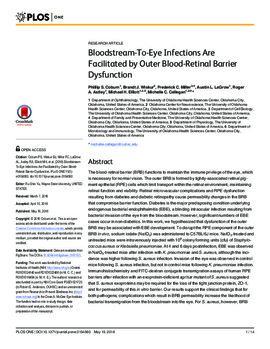| dc.contributor.author | Phillip S. Coburn | |
| dc.contributor.author | Brandt J. Wiskur | |
| dc.contributor.author | Frederick C. Miller | |
| dc.contributor.author | Austin L. LaGrow | |
| dc.contributor.author | Roger A. Astley | |
| dc.contributor.author | Michael H. Elliott | |
| dc.contributor.author | Michelle C. Callegan | |
| dc.date.accessioned | 2017-03-04T01:59:56Z | |
| dc.date.available | 2017-03-04T01:59:56Z | |
| dc.date.issued | 2016-05-19 | |
| dc.identifier.citation | Coburn PS, Wiskur BJ, Miller FC, LaGrow AL, Astley RA, Elliott MH, et al. (2016) Bloodstream-To-Eye Infections Are Facilitated by Outer Blood-Retinal Barrier Dysfunction. PLoS ONE 11(5): e0154560. doi:10.1371/journal.pone.0154560 | en_US |
| dc.identifier.uri | https://hdl.handle.net/11244/49236 | |
| dc.description | This work was funded by National Institutes of Health (NIH; http://www.nih.gov) Grants R01EY024140 and R21EY022466 (to M.C.C.) and R01EY019494 (to M.H.E.). Our research is also funded in part by NIH Core Grant P30EY021725 (to Robert E. Anderson, OUHSC) and an unrestricted grant from Research to Prevent Blindness Inc. (http://www.rpbusa.org) to the Dean A. McGee Eye Institute. The funders had no role in study design, data collection and analysis, decision to publish, or preparation of the manuscript.We thank Bolanle Adebayo (Cameron University, Lawton OK), Craig Land (Oklahoma State University, Stillwater OK), Nathan Jia (Oklahoma Christian University, Edmond OK), Kobbe Wiafe (Oklahoma School of Science and Mathematics, Oklahoma City OK), and Amanda Roehrkasse and Madhu Parkunan (OUHSC) for intellectual discussions and technical assistance. The authors also acknowledge thank Nanette Wheatley, Dr. Feng Li, and Mark Dittmar (OUHSC Live Animal Imaging Core, P30EY021725) for their invaluable technical assistance.This work was presented in part at the 2014 Association for Research in Vision and Ophthalmology Annual Conference in Orlando FL. | en_US |
| dc.description | | en_US |
| dc.description.abstract | The blood-retinal barrier (BRB) functions to maintain the immune privilege of the eye, which is necessary for normal vision. The outer BRB is formed by tightly-associated retinal pigment epithelial (RPE) cells which limit transport within the retinal environment, maintaining retinal function and viability. Retinal microvascular complications and RPE dysfunction resulting from diabetes and diabetic retinopathy cause permeability changes in the BRB that compromise barrier function. Diabetes is the major predisposing condition underlying endogenous bacterial endophthalmitis (EBE), a blinding intraocular infection resulting from bacterial invasion of the eye from the bloodstream. However, significant numbers of EBE cases occur in non-diabetics. In this work, we hypothesized that dysfunction of the outer BRB may be associated with EBE development. To disrupt the RPE component of the outer BRB in vivo, sodium iodate (NaIO3) was administered to C57BL/6J mice. NaIO3-treated and untreated mice were intravenously injected with 108 colony forming units (cfu) of Staphylococcus aureus or Klebsiella pneumoniae. At 4 and 6 days postinfection, EBE was observed in NaIO3-treated mice after infection with K. pneumoniae and S. aureus, although the incidence was higher following S. aureus infection. Invasion of the eye was observed in control mice following S. aureus infection, but not in control mice following K. pneumoniae infection. Immunohistochemistry and FITC-dextran conjugate transmigration assays of human RPE barriers after infection with an exoprotein-deficient agr/sar mutant of S. aureus suggested that S. aureus exoproteins may be required for the loss of the tight junction protein, ZO-1, and for permeability of this in vitro barrier. Our results support the clinical findings that for both pathogens, complications which result in BRB permeability increase the likelihood of bacterial transmigration from the bloodstream into the eye. For S. aureus, however, BRB permeability is not required for the development of EBE, but toxin production may facilitate EBE pathogenesis. | en_US |
| dc.language.iso | en_US | en_US |
| dc.publisher | PLos One | |
| dc.relation.ispartofseries | PLoS ONE 11(5): e0154560 | |
| dc.relation.uri | http://www.plosone.org/article/info%3Adoi%2F10.1371%2Fjournal.pone.0154560 | |
| dc.rights | Attribution 3.0 United States | |
| dc.rights.uri | https://creativecommons.org/licenses/by/3.0/us/ | |
| dc.subject | Staphylococcus aureus,Eyes,Klebsiella pneumoniae,Diabetes mellitus,Eye diseases,Mouse models,Permeability,Vascular permeability | en_US |
| dc.title | Bloodstream-To-Eye Infections Are Facilitated by Outer Blood-Retinal Barrier Dysfunction | en_US |
| dc.type | Research Article | en_US |
| dc.description.peerreview | Yes | en_US |
| dc.description.peerreviewnotes | http://www.plosone.org/static/editorial#peer | en_US |
| dc.identifier.doi | 10.1371/journal.pone.0154560 | en_US |
| dc.rights.requestable | false | en_US |

